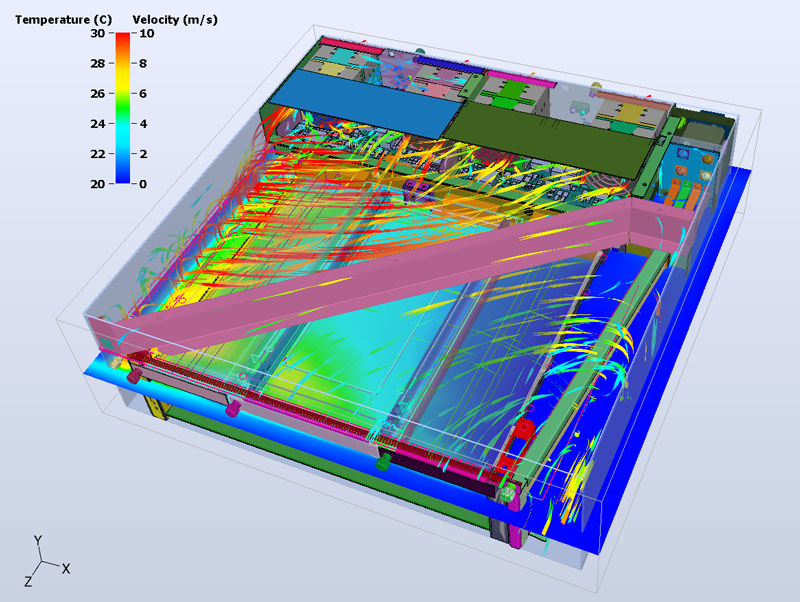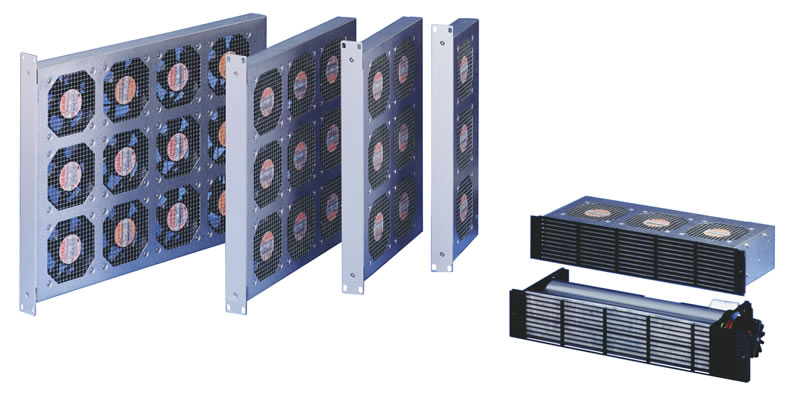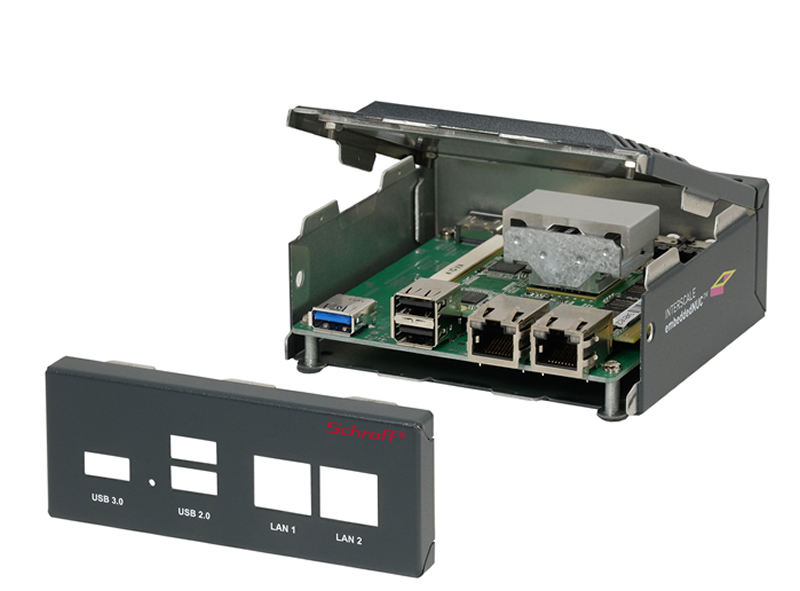Effective cooling for electronic systems
Dr. Adam Pawlowski, Principal Engineer for Cooling at Pentair Technical Solutions talks about the prevention of excessive heat build-up and targeted heat dissipation.
Refined cooling strategies are essential for preventing thermal overloads. Due to increasing electronic component density and power levels that lead to the generation of more heat, there is a significant increase in the risk of failure in electronic devices and systems. This is why case manufacturers like Pentair offer a wide range of products with suitable solutions for all cooling requirements.

Natural convection cooling: As much cooling as needed
When selecting the type of cooling required for your specific application, there are two key performance factors to consider: The maximum permitted component temperature (defined by the amount of power loss) and the basic conditions at the installation site. The use of natural convection cooling is the most cost-effective method for dissipating heat out of a cabinet or case. This is typically only an effective method, however, if enough of the total energy is passed to the outside air to avoid exceeding the maximum permitted component temperature. For enclosed cabinets or cases, this transfer of air occurs predominantly through the side panels, which must provide free circulation of air from both the inside and outside of the enclosure. The ambient temperature must be significantly below the specified temperature inside the case. Free convection as a heat dissipation solution meets its limits, however, when handling large amounts of heat. This is because the amount of dissipated heat (energy) has a linear relationship with the case surface area and the temperature difference between the inside and outside.
Increasing the coefficient of heat transfer α (although h for heat transfer coefficient is often used) can help here, but this requires switching over to forced type of convection cooling. Forced airflow on the inside of the cabinet or case by itself can increase the amount of heat dissipated by up to 50%.
Forced air convection cooling: Air cooling with fans
The most common form of cooling is forced air cooling, a method that is sufficient for the majority of enclosure solutions. Here, natural convection is boosted by the use of fans or fan trays or in some cases the latter are deployed when the air resistance of the internal components becomes too great for natural convection alone. Here again, the ambient temperature must be significantly lower than the specified internal system temperature. Forced cooling techniques can be divided into two basic approaches: Push cooling or pull cooling. In push cooling, the fans are positioned in front of the components to be cooled and push the air towards and past the hot components. In pull cooling, on the other hand, the fans are mounted behind the components; they draw (pull) the air through the components. Combining the two types of cooling is also an option. Local conditions determine which of the two solutions is used. For the push solution, for instance, the heat generated by the fans has to be added to the energy equation. For the pull solution, the thermal load (and the lifespan of the fans as a result) has to be taken into account as well.

The following parameters play a critical role in choosing the correct fans:
- The fans must be set up for maximum airflow capacity, including all redundancy scenarios and the potential elevation of the installation site above sea level. Even at an elevation of just 1000m, the available air has to be increased by approximately 18%.
- The maximum current draw of the individual fans must be considered to fit the system's available power.
- The heat generated by the fans has to be taken into account in the total heat balance sheet (especially in a push solution).
- Size, geometry and airflow must be adapted to the available space. This often entails the choice of whether axial or radial fans may be used.
- The fans must meet the specified conditions regarding available voltage (e.g. 230VAC or 24VDC, etc.), the specified alarm signals and the control type (e.g. temperature dependent speed control).
- The choice of fans must be based on the maximum noise emission specified and/or permitted for generation at the operating point. This requires more than just following the manufacturer's specifications. The air flow and turbulence that is actually generated and the empirical global noise level have to be taken into account.
Cooling without fans: Conduction cooling
Cooling through conduction refers to heat transfer within the case or subrack that uses direct material contact between two components instead of using air as a medium. Each material contact is subject to a specific thermal resistance; this value affects the heat transfer all along the conduction cooling chain. The technical means of implementing conduction cooling takes several forms.
Clamshell technology
Clamshell technology from Pentair is one available option. Clamshells are equipped with Wedge-Loks/Card-Loks on the top and bottom as well as an insertion/extractor handle. This ensures the completely assembled configuration will provide the most secure retention of PCBs in the system, this also enables effective heat conduction thanks to metal-to-metal contact. PCBs normally have components on both sides and the clamshell design encloses the entire PCB assembly. Two designs are typical: A flat inner contour and a custom-machined inner contour. The machined inner contour corresponds to a negative relief of the components on the printed board and is intended to provide as many contact points as possible between the inside of the clamshell and the heat-generating components. For optimal heat transfer, special elastic, heat-conductive pads are also used. This causes the heat to pass directly to the clamshell to the outside of the subrack or case. The limiting factor is the capacity for transferring the heat from the chassis to the air. There are a variety of strategies for addressing this challenge, such as using fans to provide forced air cooling over smooth or ribbed surfaces.
Flexible heat conductor
Specifically for cases with a very small form factor or for embedded systems that have to be completely enclosed because of their application area, heat from sources that generate high temperatures (usually processors) is also dissipated using conduction cooling. Typical heat conductor solutions in use to date have been solid metal blocks with thermal pads or thermal paste, which dissipate the heat to the surface of the case. Pentair has developed FHCs (Flexible Heat Conductor) for applications like this. They are made of aluminum, which has a very high coefficient of heat conductivity, and have a flexible height. This lets the FHC maintain consistent contact with components, such as processors. This eliminates any issues that can be the result of various height tolerances. The heat conductors are either attached to the processors by means of the existing mounting points on the PCB or, in the case of smaller processors, the heat conductors are attached to the processor using thin, heat-conducting, double-sided adhesive tape.

Cooling the whole cabinet
If a number of subracks or cases are installed in one cabinet, it may be necessary to implement additional measures to assist in providing the required airflow. This can include cooling an entire, enclosed cabinet. The starting point is the implementation of additional rear door fans or top panel fans. In some specific cases, pressure blowers can provide a sufficient amount of cooling air in the front area of the cabinet. Cabinets cooled this way are often connected to an existing air-conditioning system. Air-to-air heat exchangers, air-to-water heat exchangers and air conditioners are also used for enclosed cabinets.
The critical factors for choosing the appropriate cooling strategy are the installation site (e.g. office, laboratory or industrial environment with associated requirements for noise level or IP protection), the basic prevailing conditions (e.g. availability of raised floors, cold water connection, air-conditioning system) and ambient influences (e.g. ambient temperature, additional thermal radiation, air pollution, increased humidity). The various thermal components must always be properly matched both to the required overall performance and to the other thermal components employed. This means, for instance, that the fans used to generate forced air cooling must not cause electromagnetic interference with each other.
Software for thermal analysis
A thermal simulation of heat generation and its effects in an electronics case or cabinet is helpful, and nowadays often unavoidable. This simulation is performed using purpose-designed software. In developing its cases, subracks and cabinets, Pentair works with two different 3D software packages: 6Sigma and FloTHERM. Pentair offers a service for customers engaged in developing their own equipment to utilise its environmental lab, complete with a walk in climate chamber and wind tunnel including thermal simulation, together with the expertise of the thermal specialists.
The principle behind the simulation software is relatively straightforward. The user puts together a geometric 3D model of his or her system from a set of component types. The software can also import this data from a CAD system. If the program is used purely for case development, the inner layout consists of an average test layout with standardized components (hard drives, power supply, etc.) that most closely approximate the later application. If the simulation is being run for a customer's project, the components the customer intends to put in its system are "installed". Then the physical parameters are determined, such as the material constants, power loss of the installed components, power levels and characteristics of the fans, ambient parameters and similar factors. Then the software calculates the respective configuration state based on the convection, forced air flow, radiation and thermal conduction using a 3D mesh generated for this purpose.
The calculated flow field is analysed and represented graphically with regard to temperature, pressure and air speed trends as a result. Then the engineer can determine suitable optimisation measures, such as using different fans, altering the positioning of the fans in the system, placing air inlets in specific locations, integrating air deflectors, using other materials or material thicknesses, or trying a different arrangement of the installed components. Calculations are often run on several variants until a satisfactory case or system layout is achieved. The use of simulation tools optimises the cooling strategy early on and reduces development time and expense.
Keeping an eye on energy efficiency
A key aspect of cooling design for electronics is aiming for higher energy efficiency at an early stage. While generating as little power loss as possible is the ideal, the unavoidable loss that is generated should be dissipated as efficiently as possible. The designer should check in each instance whether the cooling solution and components selected are in fact the most suitable in terms of energy efficiency. Optimising airflow with respect to energy efficiency is also important, up to and including opting for a different ventilation strategy. In addition, it is important to examine whether the entire energy costs for cooling could be reduced by using water cooling or other means of air conditioning instead of an abundance of fans.










